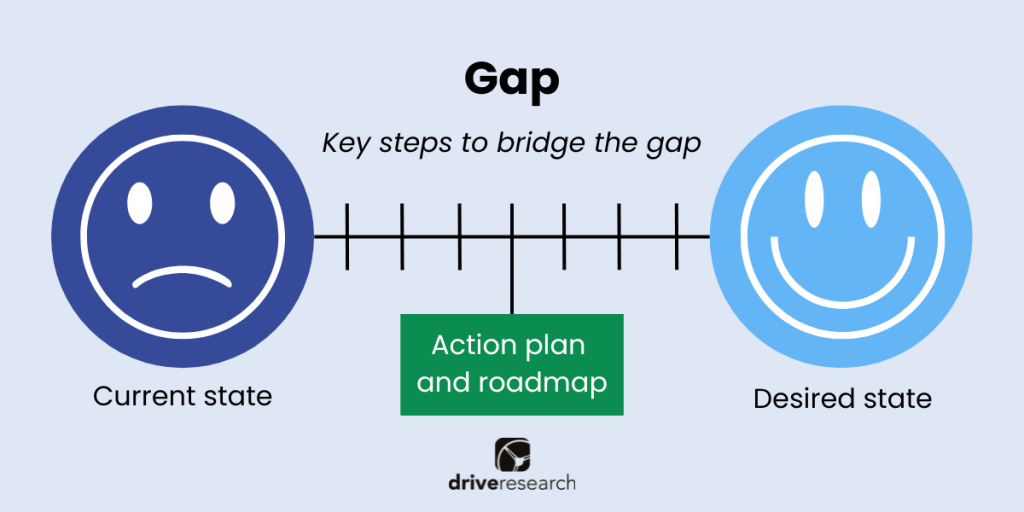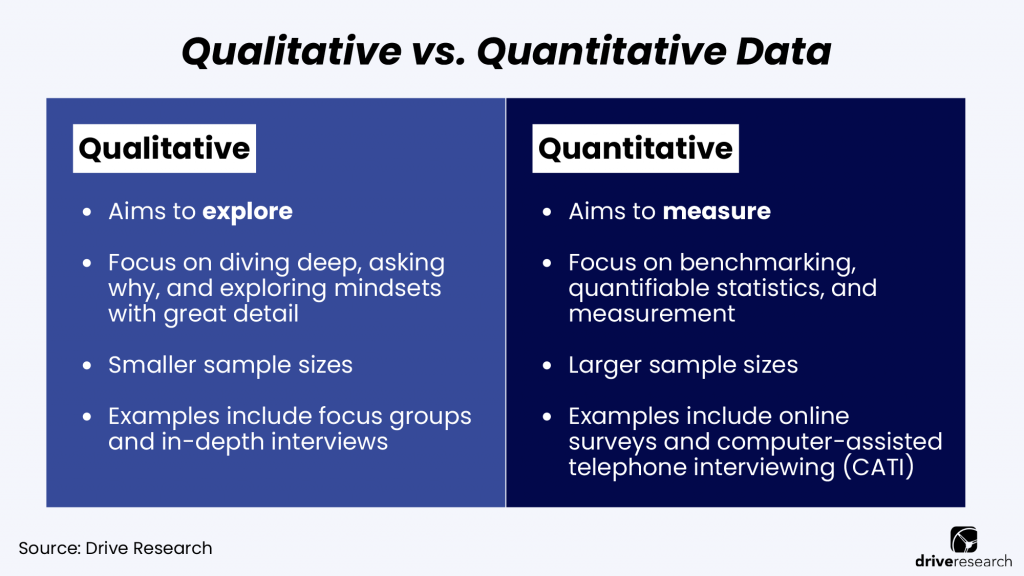
Competition is everywhere in business – and staying ahead is crucial.
You are likely aware of who your competition is, what they are doing, and how you are different.
But, conducting a gap analysis using market research is valuable to identify your strengths, weaknesses, opportunities, and threats (SWOT) for your business and your key competitors.
If you can qualify and detail these gaps, even with your organization (differences between expected performance and actual performance), you create a prioritized roadmap to develop effective strategies to bridge the divide and achieve business goals.
What Is a Gap Analysis in Market Research?
Gap analysis in market research involves assessing the disparity between current market conditions and the desired state or potential opportunities.
It helps identify areas where a product or service is not meeting customer needs, where competitors may have an advantage, or where there are unexplored market segments.
By analyzing these gaps, businesses can develop strategies to bridge them, improve their offerings, and stay competitive in the market.
Understanding the Purpose of a Gap Analysis
All businesses aim to improve, but understanding how wide the gap is can be insightful.
A core function of the gap analysis is to analyze several business areas and identify priority gaps that would generate the best return on investment to fix.
By doing this, businesses can apply time and resources more appropriately, backed by facts and evidence.
In addition to examining the gaps in your business, examining the competition on the same factors is crucial.
Measurements of current performance versus the desired expectation are valuable to understand with competitors.
This data helps examine your gaps on two different dimensions:
- Your current performance vs. the desired performance
- Your current performance vs. the competitor’s current performance

In addition to prioritizing your gaps, competitive intelligence (CI) helps your organization examine your strategy in terms of the competition as well.
For example, if you run your internal gap analysis and determine shipping time to households is the largest gap between current and desired states, one might think this should be priority number one to fix.
However, what if you learn this gap is also the largest downfall of your 4 other major competitors – meaning they are not shipping products to households quickly?
Maybe through the competitive analysis, you learn that product quality for all 4 competitors is rated higher than your own, which is the number one driver to purchase.
Wouldn’t that outside perspective through your competitive gap analysis change your perception and area of focus?
Selecting the Right Gap Analysis Tools
Leveraging market research for your gap analysis is a must-have.
Although you may have opinions, a board, or a strategy team who thinks they can identify gaps, it is always best to gather objective and unbiased data.
Better is the opinion of the buyer, not the seller.
Many market research methodologies and tools are available for gap analysis, each with strengths and weaknesses.
Some core options for gap analysis include both qualitative and quantitative options such as surveys, interviews, and focus groups.

1. Online Surveys
Online surveys are the most quantifiable, cost-effective, and timely tool to collect feedback for a gap analysis.
Working with a full-service online survey company can help you create a well-structured questionnaire to carve out valuable information from your stakeholder audiences (customers, lost customers, potential customers, competitive users, board members, employees, distributors, etc.)
Although surveys can be conducted by mail or phone, we always recommend online and email surveys.
Phone methodologies are often utilized as part of mixed-mode studies.
Often (particularly with B2B audiences), phone outreach can be leveraged to contact non-responders or ensure feedback is received from the most valuable stakeholders.
For example, if you have 1,000 customer accounts but deem only 25 as A+/high-value accounts, you may focus on reminder phone calls and efforts there to obtain a response.
You can quickly reach many and a wide range of respondents with surveys.
With so much data reported back, it becomes a statistically reliable dataset to carve out findings and compare segments.
This is a vital methodology for gap analysis.
Focus Groups or Interviews
Whereas quantitative research aims to measure, qualitative research aims to explore and dive deep into experiences.
Focus groups and interviews allow professional moderators to peel back the onion and understand underlying motivations. It explains the why behind actions and behaviors.
Focus groups can be conducted online or in person and typically include 4-10 participants in a room led by a facilitator. Sessions last 60 minutes to 2 hours.
Similarly, one-on-one in-depth interviews (IDIs) can be hosted in person or online.
They typically last 30-60 minutes and remove any group bias in a focus group. It allows for much more 1:1 time with each participant to dive into the experience.
When combined with quantitative data, you can understand the entire SWOT of a business from all angles.
Qualitative vs. Quantitative: How to Choose?
The type(s) of market research you utilize for your study depends on several factors.
To create the best approach, you must consider a budget, timeline, target audiences, and more.
The investment in market research can vary significantly for qualitative and quantitative studies depending on the length of the sessions, how niche the target audiences are, type of methodology, number of participants, incentives, level of reporting, etc.
The Role of Data Collection and Analysis in a Gap Analysis
The accuracy and reliability of the data you collect are critical.
Although you can worry less about the quality of data with your employees and customers compared to utilizing panels to collect market data, proper planning, sampling methods, data quality checks, and data management must be in place.
Consider the following when developing your sample plan.
- Target audiences: customers, non-customers, employees, shareholders, subject matter experts, etc.
- Geographies: areas of the country or world to sample as part of your market research.
- Sample size: how many participants do you want to sample? Do you have critical segments?
It is important to remember and consider qualitative and numerical data collected through quantitative outreach.
The above criteria should also be considered for any focus groups or interviews you are considering and how you want to mirror critical audiences.
Strategies for Interpreting Gap Analysis Results
Take a Systematic Approach
With any good analysis and interpretation, take a systematic approach.
Remember, the goal is to prioritize identified gaps based on their impact on your business performance.
Consider grouping the gaps for you and competitors into minor, moderate, major, etc., or using a 1-5 scale where “5” identifies critical.
Once the essential gaps are identified, it becomes clear what the focus should be.
Take Action With the Findings
From there, strategies can be discussed and developed to close those gaps.
It might include process improvements, training programs, or technology upgrades. Your organization should examine all those potential outcomes for feasibility, return on investment, cost, and expected outcomes.
Use Data Visualizations
Consider using data visualizations to help outline the major themes of your gap analysis for stakeholders.
Having a well-thought-out plan that’s digestible and actionable should help achieve buy-in.
Make the Results Easy to Comprehend
Moreover, it is vital to consider the audience when presenting the results. Stakeholders may have different technical expertise or familiarity with the subject matter.
Therefore, it is essential to tailor the presentation to meet the audience’s needs.
This might involve simplifying complex concepts, providing real-life examples, or using analogies to make the information more relatable.
Collaborate and Listen
Furthermore, engaging stakeholders in interpreting and presenting the gap analysis results can foster a sense of ownership and commitment to the proposed strategies.
Organizations can benefit from diverse perspectives and insights by involving critical individuals from different departments or teams.
This collaborative approach can lead to more effective and sustainable solutions.
Overcoming Gap Analysis Challenges and Pitfalls
While a gap analysis can be extremely useful for a business, it is crucial to understand and at least be conscious of potential challenges, biases, and pitfalls.
- Data Accuracy: Was the market research conducted by an objective firm with reliable methodologies, and was enough data obtained to draw reliable conclusions?
- Overfocus on Weaknesses and Threats: While closing gaps and improving weaknesses is essential, something can also be said for understanding your core differentiators and factors of your brand experience that make your business stand out and doubling down on those in marketing strategies.
- Market or External Factors: Depending on when the gap analysis was conducted, many macroeconomic factors could impact your analysis (e.g., industry trends and regulatory changes).
Contact Our Gap Analysis Company
Our global market research firm works with brands worldwide to assist with their gap analysis studies and programs.
Our strength is creating a custom plan backed by rigorous market research methodologies that produce quality data from your stakeholder audiences. We then interpret this data and provide an execution plan and recommendations to understand differentiators and prioritize fixing gaps. Contact us today to learn more about our services.



